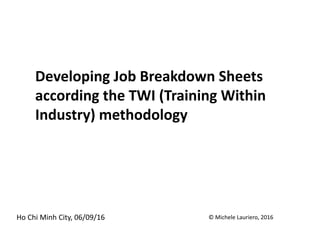
Developing Job Breakdown Sheets according TWI methodology
- 1. Developing Job Breakdown Sheets according the TWI (Training Within Industry) methodology Ho Chi Minh City, 06/09/16 © Michele Lauriero, 2016
- 2. TWI – Training Within Industry History of the TWI methodology: • Developed in 1940’s in U.S.A. to quickly develop and re-train unskilled work force in the industry
- 3. • TWI gave excellent results. All companies applied it reported: increased productivity (> 25%) reduced training time (> 25%) • After the war USA exported the TWI methodology in Japan to help the industrial rebuilding • The TWI methodology was adopted by Toyota, improved and become part of the T.P.S. • Today TWI is part of the “lean management” tools used worldwide to standardize the work, standardize the training of workers and quickly raise skills on production floors.
- 4. What is TWI? The Training Within Industry TWI program is all about training and coaching supervisors (“train the trainers”) giving them: 1. Knowledge of the work 2. Knowledge of the responsibilities of the job
- 5. The 3 J’s program JI — Job Instruction Training — to train supervisors how to train employees to quickly learn and consistently remember how to do any job correctly and safely. JM — Job Methods Training — to train supervisors how to lead teams to quickly improve job methods to produce more in less time, making the best use of resources. JR — Job Relations Training — to train supervisors how to lead people in ways that prevent and quickly resolve problems. The J.B.S. are developed to support this phase of program.
- 6. JBS
- 7. The J.B.S. • Synthetic way to standardize the work optimizing the skill transfer to new employees • It focus on main points and not list each single detailed motion • It is not a “Complete Instructions Manual” for the job that can be handed to the employees • The main purpose is to help the instructor organize the job in their mind and determine the best way to convey this knowledge to the employee • It’s written by the instructor as a tool “from us to our-self” • They are organizing tools for the trainer, not for handing over to the learner
- 8. What is inside a JBS • Complete information about the task, task number, parts and components used, tools, material, safety equipment, etc… • Major Steps: As it says – only major steps Always start with a “verb” Single short sentences • Key points: Safety Quality Tip and tricks (knowledge based on experience) • Reasons
- 9. First part – Task information
- 10. Second part – Job breakdown
- 11. MAJOR STEPS Any logical segment of the operation that helps advance the job or adds value to the product. • List all the steps in the actual sequence performed usually • Focus on the operator point of view • Major steps is not a full description of motions to be done Example: Screw the winch flange on deck Yes – is a M.S. Get screw driver from the toolbox No - isn’t a M.S. KEY POINTS Any important issue related to quality, safety and information to know to make the job better. Each M.S. may have more than one K.P. Typical key points are info that: 1. Make the job 2. Break the job 2. Injure the worker 3. Make the work easier Use graphic symbol to make the JBS visual: REASON There is a difference between child education and adult education. Most of the adults while learning need to know the reason – WHY? • Quality precautions • Waste prevention • Health precautions • How the final result should look like • How match one part to the other
- 12. Third part – Pictures / Training aid USE PICTURE FOR EFFICIENT VISUAL REPRESENTATION OF KEY POINTS Check pressure. The right value must be between 0.5 and 2.4 bar What’s better?
- 13. Practical example – Replace a wheel
- 14. • Efficient way to standardize the work • Rely on real technical document instead of memory • Strong tool for a fast and effective training • Starting point for a real “kaizen” on the floor • Give strong value to the “supervisors” (team leaders) Benefit of a well done set of JSBs
